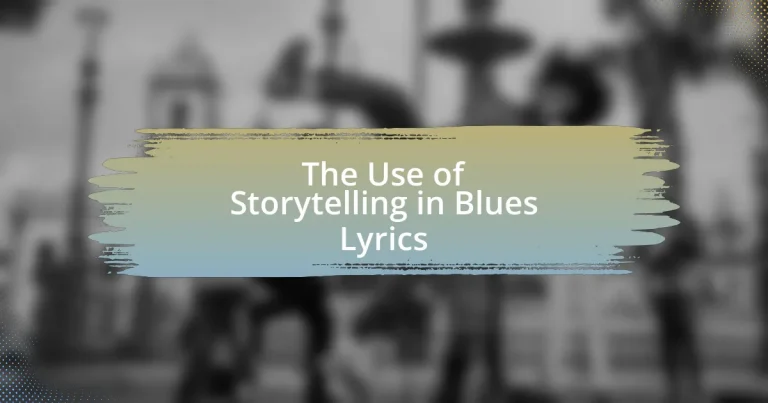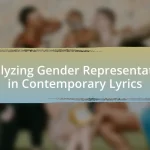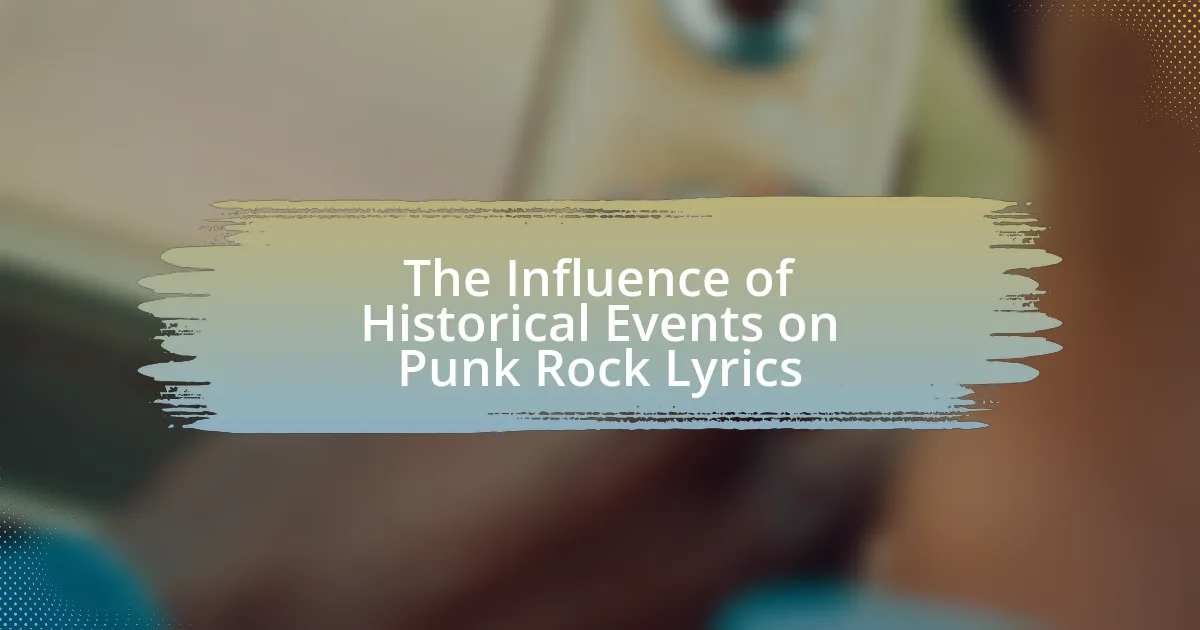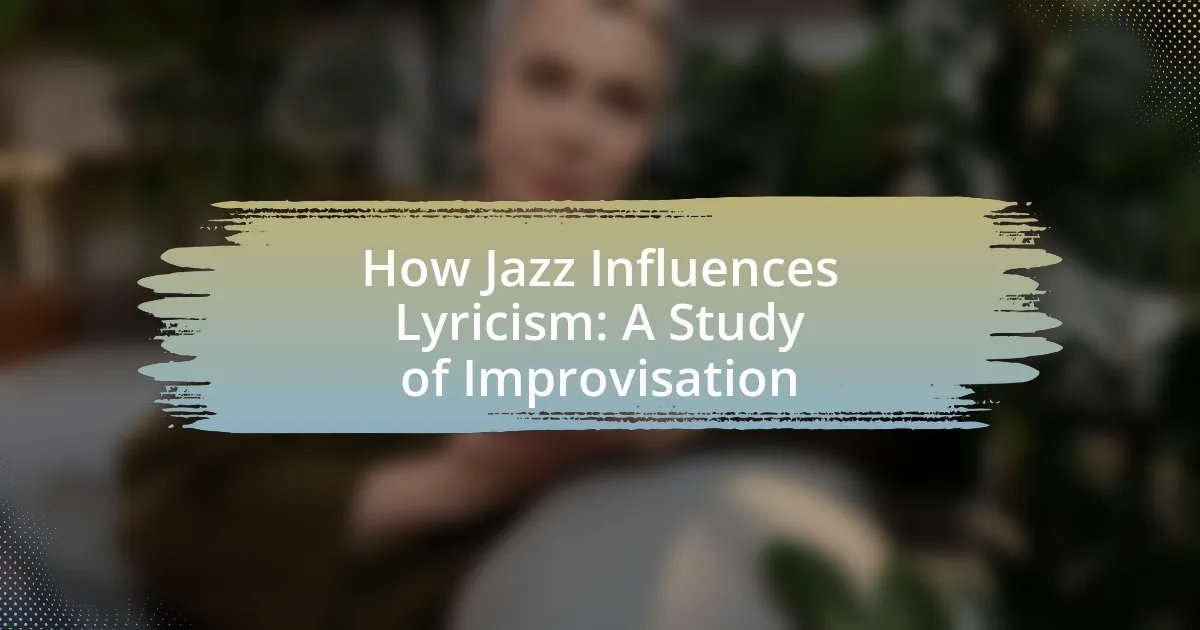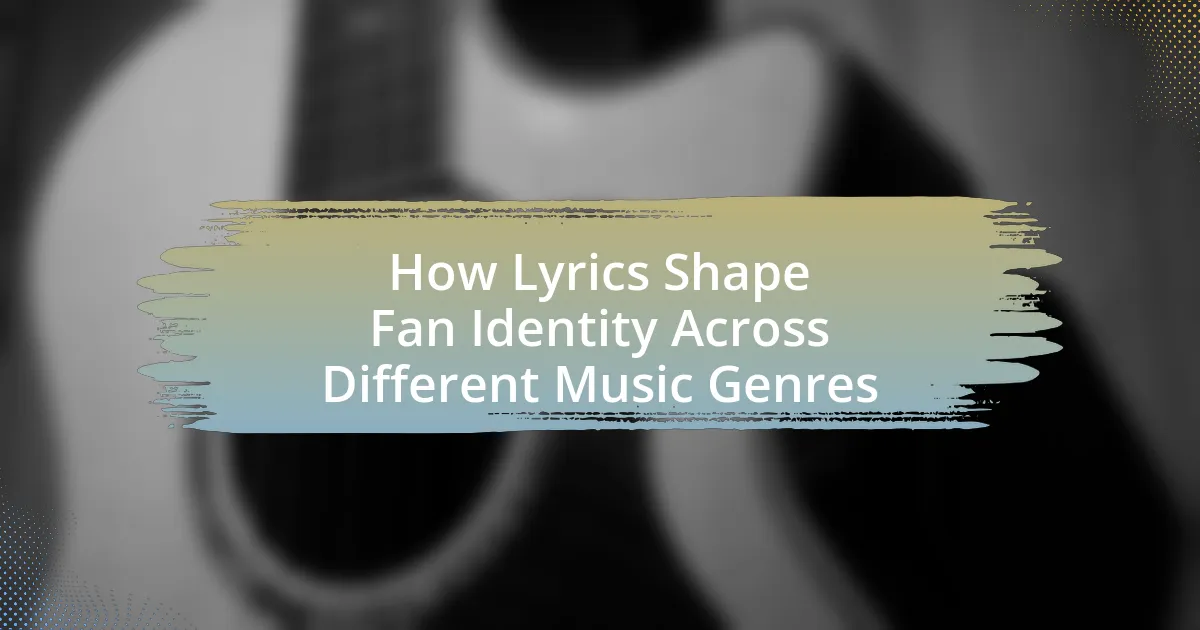The article examines the role of storytelling in blues lyrics, highlighting its significance in conveying personal experiences, emotions, and social commentary. It discusses how narrative techniques enhance the emotional depth of blues music, with a focus on common themes such as hardship, love, and resilience. The article also explores the historical contexts that influence storytelling in blues, the use of vivid imagery, and how personal experiences shape the narratives. Additionally, it addresses the diverse storytelling styles of various blues artists and provides insights into how aspiring musicians can effectively incorporate storytelling into their lyrics.
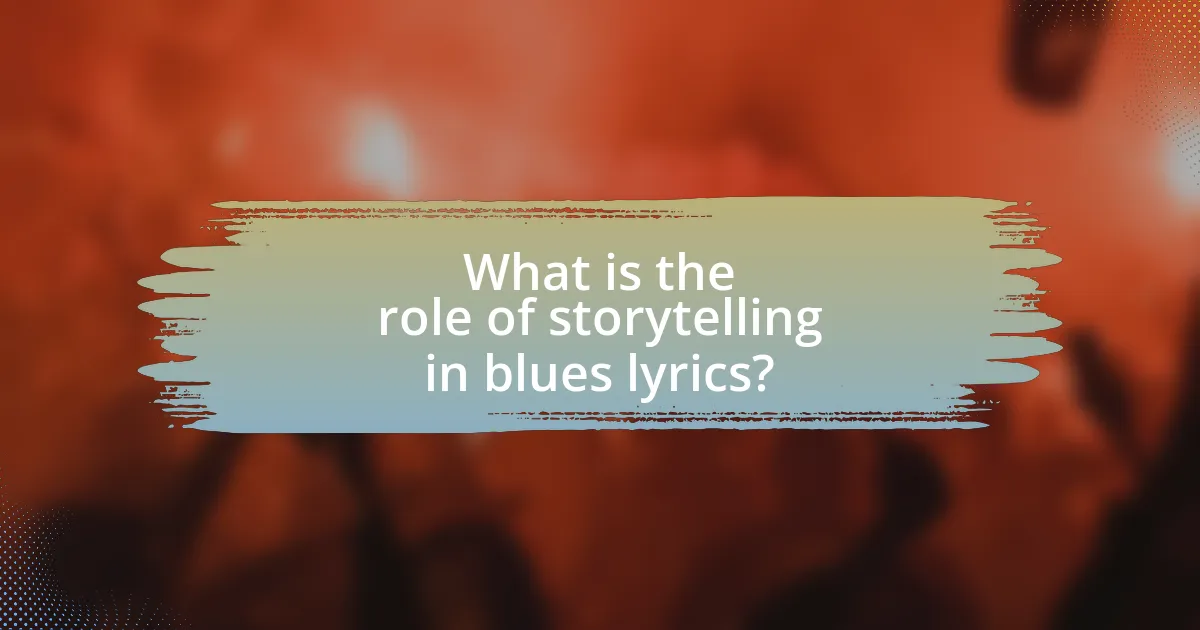
What is the role of storytelling in blues lyrics?
Storytelling in blues lyrics serves to convey personal experiences, emotions, and social commentary, often reflecting the struggles and resilience of the human condition. This narrative technique allows artists to connect deeply with listeners by sharing authentic tales of hardship, love, and loss. Historically, blues music emerged from African American communities in the early 20th century, where oral traditions were vital for preserving cultural identity and history. The storytelling aspect is evident in classic blues songs, such as “The Thrill Is Gone” by B.B. King, which narrates themes of heartbreak and longing, illustrating the genre’s focus on relatable life experiences.
How does storytelling enhance the emotional depth of blues music?
Storytelling enhances the emotional depth of blues music by allowing artists to convey personal experiences and universal themes of suffering, love, and resilience. This narrative approach creates a connection between the listener and the artist, as the stories often reflect real-life struggles and emotions. For instance, blues songs frequently incorporate elements of hardship and loss, which resonate deeply with audiences, fostering empathy and understanding. Historical examples include the works of artists like B.B. King and Muddy Waters, whose lyrics often narrate tales of heartbreak and perseverance, illustrating the genre’s roots in African American history and culture. This storytelling tradition not only enriches the musical experience but also preserves cultural narratives, making blues music a powerful medium for emotional expression.
What narrative techniques are commonly used in blues lyrics?
Blues lyrics commonly utilize narrative techniques such as first-person storytelling, vivid imagery, and repetition. First-person storytelling allows the singer to convey personal experiences and emotions, creating a direct connection with the listener. Vivid imagery paints detailed scenes that evoke strong emotions, often depicting themes of hardship, love, and loss. Repetition emphasizes key phrases or ideas, reinforcing the emotional weight of the narrative. These techniques are integral to the blues genre, as they enhance the storytelling aspect and resonate deeply with audiences, reflecting the lived experiences of the artists.
How do personal experiences shape the stories told in blues songs?
Personal experiences significantly shape the stories told in blues songs by providing authentic emotional depth and relatable narratives. Blues music often reflects the struggles, heartaches, and triumphs of individuals, drawing from real-life events such as poverty, love loss, and social injustice. For instance, artists like B.B. King and Muddy Waters infused their personal histories into their lyrics, creating a connection with listeners who may share similar experiences. This authenticity is a hallmark of the genre, as it allows for a raw expression of feelings that resonates deeply with audiences, making the stories not only compelling but also reflective of the broader human condition.
Why is storytelling a fundamental aspect of the blues genre?
Storytelling is a fundamental aspect of the blues genre because it serves as a vehicle for expressing personal and communal experiences, often reflecting themes of struggle, heartache, and resilience. The blues originated in the African American communities of the Deep South in the late 19th century, where oral traditions were vital for sharing life stories and cultural heritage. This narrative style allows artists to convey deep emotions and connect with listeners on a profound level, making the music relatable and impactful. Historical examples include the works of artists like B.B. King and Muddy Waters, whose lyrics often narrate tales of love lost and life’s hardships, illustrating the genre’s reliance on storytelling to evoke empathy and understanding.
What historical contexts influence storytelling in blues lyrics?
Historical contexts that influence storytelling in blues lyrics include the African American experience, particularly during the periods of slavery, segregation, and the Great Migration. The blues originated in the Deep South in the late 19th century, reflecting the struggles, hardships, and resilience of African Americans. For instance, the legacy of slavery is evident in themes of suffering and longing for freedom, while the Great Migration saw many African Americans move to urban areas, leading to new narratives about displacement and adaptation. These historical events shaped the emotional depth and authenticity of blues storytelling, making it a powerful medium for expressing personal and collective experiences.
How does storytelling in blues reflect cultural and social issues?
Storytelling in blues reflects cultural and social issues by conveying the lived experiences of marginalized communities, particularly African Americans. The lyrics often address themes such as poverty, racism, and personal struggles, providing a narrative that highlights systemic injustices. For instance, songs like “Strange Fruit” by Billie Holiday explicitly confront racial violence and discrimination, serving as a poignant commentary on the social climate of the time. This storytelling tradition not only preserves cultural history but also fosters a sense of identity and resilience among listeners, making blues a powerful medium for social critique and cultural expression.
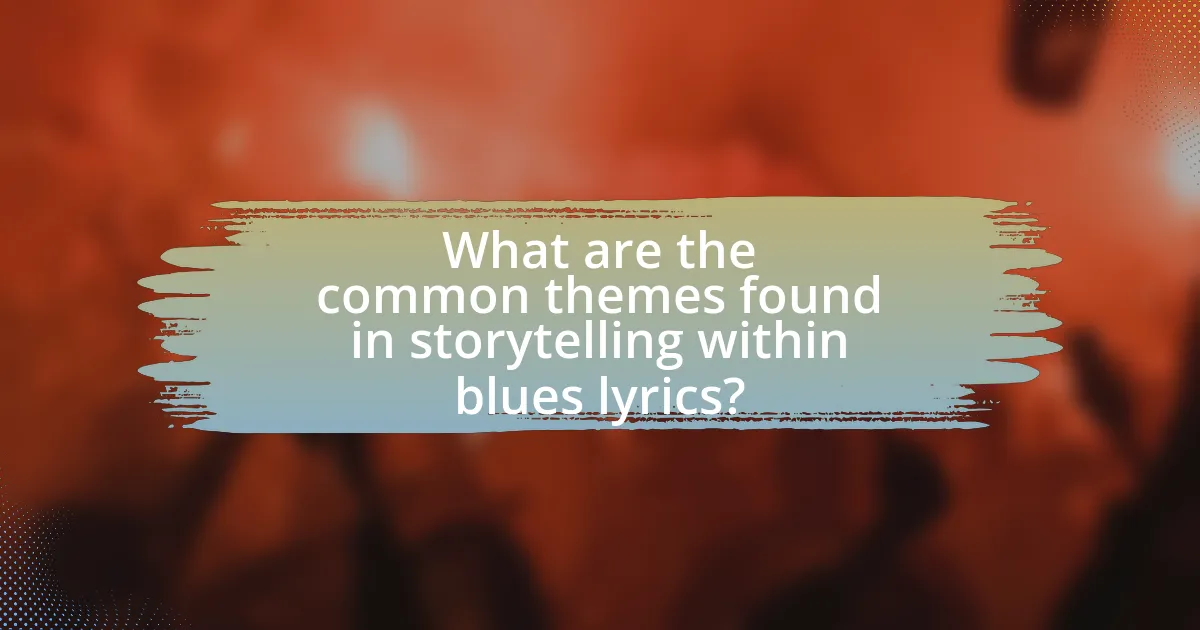
What are the common themes found in storytelling within blues lyrics?
Common themes found in storytelling within blues lyrics include hardship, love, loss, and resilience. These themes often reflect the struggles and emotional experiences of the African American community, particularly in the context of historical oppression and personal adversity. For instance, many blues songs narrate tales of unrequited love or betrayal, illustrating the pain and sorrow associated with relationships. Additionally, themes of economic hardship and social injustice are prevalent, as artists express their frustrations with systemic inequalities. The storytelling in blues serves as a powerful medium for conveying deep emotional truths, often rooted in real-life experiences, thereby reinforcing the genre’s authenticity and cultural significance.
How do themes of love and loss manifest in blues storytelling?
Themes of love and loss manifest in blues storytelling through personal narratives that express deep emotional pain and longing. Blues lyrics often recount experiences of heartbreak, betrayal, and the sorrow of lost relationships, illustrating the profound impact of love on the human experience. For example, classic blues songs like “Sweet Home Chicago” and “The Thrill is Gone” encapsulate feelings of yearning and despair, reflecting the artists’ struggles with love’s transient nature. This storytelling tradition is rooted in African American history, where the blues emerged as a means to articulate personal and collective suffering, making it a powerful vehicle for expressing the complexities of love and loss.
What specific examples illustrate love and heartbreak in blues songs?
Specific examples illustrating love and heartbreak in blues songs include “The Thrill Is Gone” by B.B. King, which expresses the pain of lost love, and “I’d Rather Go Blind” by Etta James, showcasing deep emotional sorrow from heartbreak. In “The Thrill Is Gone,” B.B. King conveys feelings of despair and longing, emphasizing the emotional weight of a relationship’s end. Etta James’s “I’d Rather Go Blind” captures the anguish of witnessing a partner’s infidelity, highlighting the intensity of heartbreak. These songs exemplify the storytelling aspect of blues lyrics, where personal experiences of love and loss resonate deeply with listeners.
How do blues artists convey resilience through their narratives?
Blues artists convey resilience through their narratives by expressing personal struggles and triumphs in their lyrics. These narratives often reflect themes of hardship, loss, and perseverance, illustrating how individuals overcome adversity. For example, artists like B.B. King and Muddy Waters frequently incorporate their life experiences, such as poverty and discrimination, into their songs, which resonate with listeners facing similar challenges. This storytelling technique not only highlights the emotional depth of their experiences but also serves as a source of inspiration, demonstrating that resilience is possible despite difficult circumstances.
What role does imagery play in blues storytelling?
Imagery plays a crucial role in blues storytelling by vividly conveying emotions and experiences. It allows artists to paint a mental picture that resonates with listeners, enhancing the narrative’s emotional depth. For instance, blues lyrics often utilize metaphors and sensory details to depict themes of sorrow, love, and hardship, making the stories relatable and impactful. This technique is evident in the works of blues legends like B.B. King and Muddy Waters, whose lyrics frequently incorporate rich imagery to evoke feelings of longing and despair, thereby reinforcing the authenticity of their experiences.
How do vivid descriptions enhance the listener’s experience?
Vivid descriptions enhance the listener’s experience by creating immersive imagery that engages the senses and emotions. When storytellers use detailed and evocative language, they transport listeners into the narrative, allowing them to visualize scenes and feel the emotions conveyed. Research indicates that sensory-rich descriptions can activate brain regions associated with perception and emotion, making the experience more relatable and impactful. For example, a blues lyric that describes a rainy night with specific details about the sound of raindrops and the smell of wet earth can evoke nostalgia and empathy, deepening the listener’s connection to the story being told.
What are some iconic images used in blues lyrics?
Iconic images used in blues lyrics include the “train,” symbolizing movement and escape, and “the crossroads,” representing choices and fate. The train often evokes feelings of longing and the desire for freedom, as seen in songs like “Midnight Train” by James Brown. The crossroads image, famously referenced in Robert Johnson’s “Cross Road Blues,” signifies pivotal moments in life and the struggle between good and evil. These images are deeply rooted in the African American experience, reflecting themes of hardship, resilience, and the quest for identity.
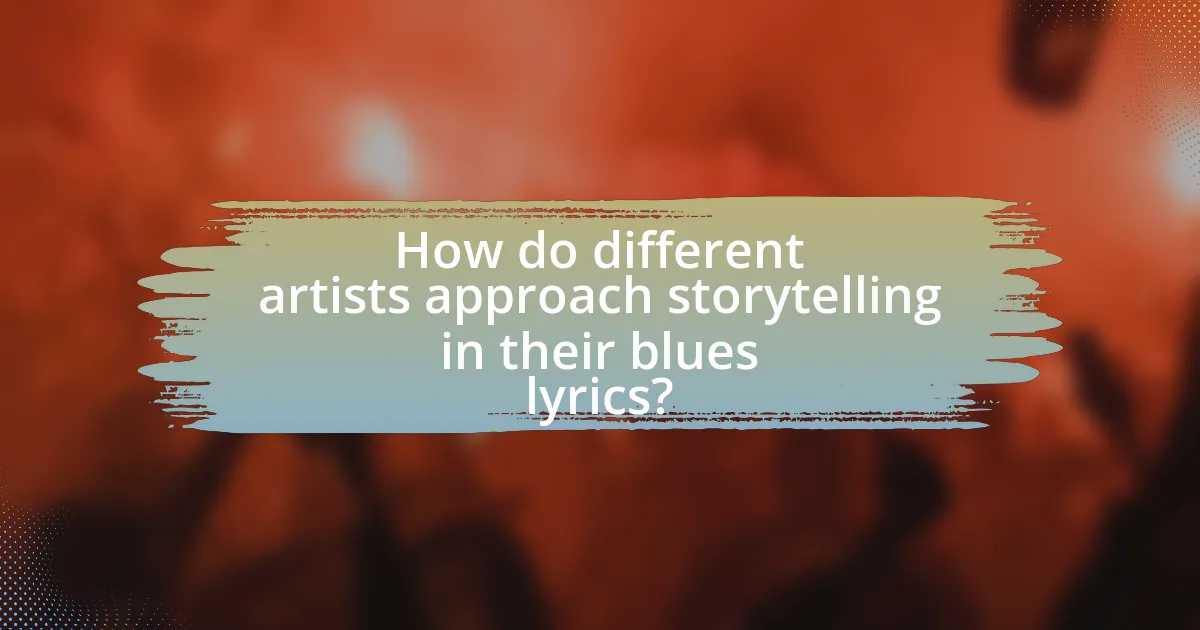
How do different artists approach storytelling in their blues lyrics?
Different artists approach storytelling in their blues lyrics through varied themes, personal experiences, and narrative techniques. For instance, B.B. King often incorporates elements of love and heartbreak, using vivid imagery to convey emotional depth, while Muddy Waters frequently tells stories of struggle and resilience, reflecting the harsh realities of life. Additionally, artists like Robert Johnson utilize symbolism and allegory, creating a mystical quality in their narratives that resonates with listeners. This diversity in storytelling methods highlights the genre’s ability to capture a wide range of human experiences, making blues lyrics a powerful medium for personal and collective expression.
What distinguishes the storytelling styles of various blues musicians?
The storytelling styles of various blues musicians are distinguished by their unique personal experiences, emotional depth, and regional influences. For instance, artists like B.B. King often incorporate themes of love and heartbreak, using vivid imagery and personal anecdotes to connect with listeners, while Muddy Waters emphasizes a more raw and gritty narrative style that reflects the struggles of urban life. Additionally, musicians from different regions, such as Delta blues artists like Robert Johnson, focus on rural hardships and spiritual themes, contrasting with the more urban narratives found in Chicago blues. This diversity in storytelling is further supported by the historical context of the blues genre, which evolved from African American oral traditions, allowing each musician to express their individual stories through distinct lyrical styles and musical techniques.
How do regional influences shape the narratives in blues music?
Regional influences shape the narratives in blues music by reflecting the cultural, social, and historical contexts of specific areas. For instance, the Delta blues, originating from the Mississippi Delta, often incorporates themes of hardship, poverty, and the struggles of African American life in the South, influenced by the region’s agricultural economy and racial tensions. In contrast, Chicago blues, which evolved from Delta blues, emphasizes urban experiences, showcasing themes of migration, industrialization, and the challenges of city life, influenced by the Great Migration of African Americans to northern cities. These regional characteristics are evident in the lyrics, instrumentation, and stylistic choices, which serve as a narrative vehicle for expressing local stories and experiences.
What are some notable examples of storytelling from legendary blues artists?
Notable examples of storytelling from legendary blues artists include Robert Johnson’s “Cross Road Blues,” which narrates a man’s desperate plea for salvation at a crossroads, symbolizing choices and fate. Additionally, Muddy Waters’ “Hoochie Coochie Man” tells the story of a man endowed with supernatural powers, reflecting themes of masculinity and mysticism. B.B. King’s “The Thrill Is Gone” conveys the emotional pain of lost love, illustrating the deep personal experiences often found in blues music. These songs exemplify how blues artists use narrative to express complex emotions and life experiences, making their storytelling impactful and relatable.
How can aspiring blues musicians effectively incorporate storytelling into their lyrics?
Aspiring blues musicians can effectively incorporate storytelling into their lyrics by focusing on personal experiences, emotions, and vivid imagery. By drawing from real-life events or feelings, musicians create relatable narratives that resonate with listeners. For instance, many classic blues songs, such as “The Thrill Is Gone” by B.B. King, illustrate heartbreak and loss through detailed storytelling, allowing the audience to connect deeply with the song’s emotional core. This approach not only enhances the authenticity of the lyrics but also engages the audience, making the music more impactful.
What techniques can be used to develop compelling narratives in blues songs?
Compelling narratives in blues songs can be developed using techniques such as vivid imagery, personal storytelling, and emotional authenticity. Vivid imagery allows listeners to visualize the experiences being described, enhancing emotional connection. Personal storytelling involves sharing real-life experiences or struggles, which resonates with audiences and creates relatability. Emotional authenticity is crucial, as expressing genuine feelings fosters a deeper connection with listeners. These techniques are supported by the historical context of blues music, which often reflects the lived experiences of African American communities, emphasizing themes of hardship, love, and resilience.
How can personal experiences be transformed into relatable blues stories?
Personal experiences can be transformed into relatable blues stories by focusing on universal emotions and experiences that resonate with a wide audience. Blues music often draws from themes of heartache, struggle, and resilience, allowing artists to convey their personal narratives in a way that others can identify with. For instance, the use of vivid imagery and specific details in lyrics can evoke shared feelings of loss or longing, making the story accessible to listeners who may have faced similar challenges. Historical context supports this approach, as many classic blues songs, such as B.B. King’s “The Thrill Is Gone,” illustrate personal pain while tapping into collective experiences of love and loss, thereby creating a bridge between the artist’s individual story and the audience’s emotions.
